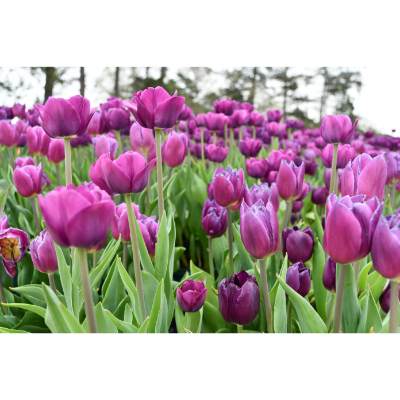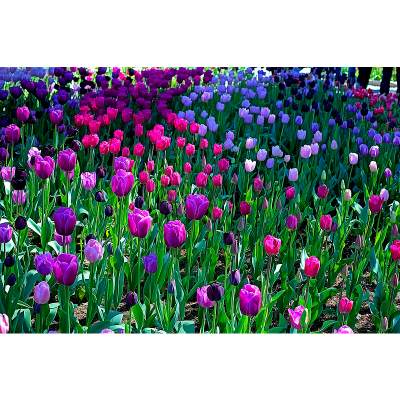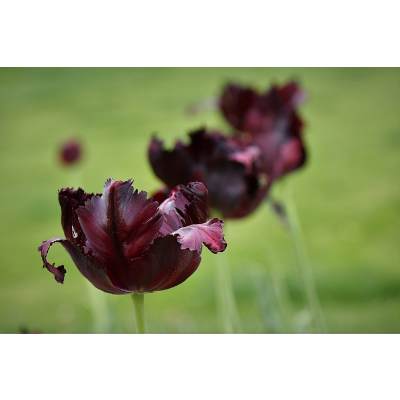How long do tulips last? If it’s cool in the spring, tulips bloom for one to two weeks. If it’s hot, each bloom may only last a few days. They can last up to ten days if you cut them and put them in a vase.
Tulips are a symbol of spring’s beauty, known for their vibrant colors and stunning presence. Understanding the factors that influence how long tulips bloom can help you make the most of their seasonal display. In this article, we’ll explore the bloom time of tulips, the impact of different varieties and growing conditions, and tips and techniques to prolong the life of your tulip blooms.
Tulips are among the iconic flowers of spring, gracing gardens, bouquets, and flower arrangements with their stunning colors and elegant shapes. But have you ever wondered how long tulips bloom, and what factors influence their blooming duration? Let’s dive into the world of tulip blooms and uncover the secrets to enjoying them for as long as possible.
The Variety of Tulip Varieties and Bloom Time
Tulips come in a wide range of varieties, each with its own unique bloom time. Early-blooming tulip varieties often make their appearance in late March or early April, heralding the arrival of spring. These tulips are the first to paint the landscape with their vibrant colors, providing a visual feast after the drabness of winter.
On the other hand, late-blooming tulip varieties can extend the tulip season well into May. These late bloomers are a fantastic way to ensure that your garden remains awash with color as spring progresses. By planting a variety of tulip types with different bloom times, you can enjoy a continuous display of tulips throughout the spring season.
Geographic Factors and Bloom Time
The geographic location in which you plant your tulips plays a significant role in determining their bloom time. Tulips thrive in regions with mild winters and moderate spring temperatures. In areas where winters are particularly harsh, tulips may start blooming later, typically in April or even May.
Conversely, regions with milder winters often experience earlier tulip blooms, with some varieties appearing as early as March. If you’re lucky enough to live in a climate with mild winters and early springs, you can enjoy the beauty of tulips sooner in the year.
Planting Time and its Influence on Bloom Time
The timing of planting tulip bulbs can also impact when they bloom. Tulip bulbs are typically planted in the fall, allowing them to establish their root systems before the onset of winter. This early planting contributes to earlier spring blooms. However, if you find yourself planting tulip bulbs later in the fall or even in early winter, you might witness slightly delayed blooming.
The fall planting period is ideal because it gives tulip bulbs the opportunity to acclimate to their environment and prepare for their spring debut. If you’re aiming for early blooms, make sure to get your bulbs into the ground during the recommended fall planting window.
The Impact of Weather on Tulip Blooming
Weather conditions can be both a friend and a foe to tulip blooms. A mild winter followed by a gradual warming in spring can encourage earlier blooming. These optimal conditions allow tulip bulbs to break dormancy at the right time, resulting in a timely and vibrant display of flowers.
Conversely, unexpected frosts or prolonged cold spells can delay tulip blooms. If tulips have already started emerging from the ground and a late frost hits, it can damage the tender buds and cause delays in their blooming schedule. Monitoring the weather and providing protection when needed can help mitigate these challenges.
In conclusion, how long tulips bloom depends on several factors, including the variety of tulip, geographic location, planting time, and weather conditions. By selecting a range of tulip varieties with different bloom times, considering your local climate, planting bulbs in the fall, and keeping an eye on the weather, you can enjoy the beauty of tulip blooms for an extended period each spring. So, embrace the diversity of tulip varieties, and let their vibrant colors brighten your garden and your spirits for weeks on end.

How Long Do Cut Tulips Last?
Cut tulips are a popular choice for home decoration and floral arrangements, bringing the beauty of the garden indoors. But how long do cut tulips last, and what factors can influence their longevity? In this article, we will explore the typical lifespan of cut tulips, the factors that affect how long they stay fresh, and practical tips to ensure your cut tulips stay vibrant for as long as possible.
Cut tulips have a unique charm, gracing vases, bouquets, and floral displays with their vibrant colors and elegant shapes. However, like all cut flowers, tulips have a finite lifespan once removed from their roots. Understanding the factors that influence the longevity of cut tulips can help you enjoy their beauty for an extended period.
Also Read :
Colors of Tulips: A Complete List of Tulip Colors
The Typical Lifespan of Cut Tulips

On average, cut tulips can last anywhere from five to ten days when properly cared for. However, several factors can affect how long they stay fresh and vibrant.
Factors Affecting Longevity
Several key factors influence how long cut tulips last:
Water and Nutrition:
Cut tulips, like all cut flowers, continue to drink water even after being harvested. Providing fresh water in a clean vase is essential to keep them hydrated and healthy. Make sure to change the water every two days to prevent bacterial growth and maintain water quality.
Environmental Conditions:
The environment in which you place your cut tulips can significantly impact their lifespan. Keep them away from direct sunlight, as excessive heat can cause them to wilt more quickly. Similarly, avoid placing them near heat sources like radiators or vents.
Proper Handling:
Gentle handling of cut tulips is crucial to prevent damage to their delicate petals and stems. When arranging them, avoid squeezing or bending the stems too much. Cut tulips are also sensitive to ethylene gas, which is emitted by fruits like apples and bananas. To prolong their freshness, keep them away from ripening fruit.
Tips to Prolong the Life of Cut Tulips
To maximize the lifespan of your cut tulips, consider these practical tips:
- Change the water every two days to maintain freshness and prevent bacterial growth.
- Recut the stems at an angle every few days to ensure they can continue to take up water effectively.
- Keep your cut tulips away from direct sunlight and heat sources to prevent wilting.
- Remove any submerged leaves or foliage in the vase to prevent bacterial growth.
- Consider using a floral preservative in the vase water to provide essential nutrients to the flowers.
By following these guidelines, you can extend the life of your cut tulips and enjoy their vibrant colors and graceful shapes for up to ten days or even longer.
Growing Tulips: Tips and Techniques

Growing tulips in your garden can be a rewarding experience, as these iconic flowers are known for their vibrant colors and elegant shapes. To ensure your tulips bloom beautifully year after year, it’s essential to provide them with the right growing conditions and care. In this article, we will explore valuable tips and techniques for growing tulips successfully in your garden.
Tulips are synonymous with spring, and their arrival is eagerly awaited by garden enthusiasts. To ensure your tulips thrive and bloom beautifully, it’s essential to provide them with the proper growing conditions and care. In this comprehensive guide, we will delve into tips and techniques for growing tulips successfully in your garden, from selecting the right soil to addressing common pests and diseases.
Soil: The Foundation for Healthy Tulip Growth
Choosing the right soil is crucial for the health and longevity of your tulip bulbs. Here are some key considerations:
- Well-Drained Soil: Tulips prefer well-drained soil to prevent bulb rot. Poorly drained soil can lead to waterlogged bulbs and fungal diseases. To improve drainage, consider amending your soil with organic matter like compost.
Sunlight: The Energy Source for Tulip Growth
Tulips thrive in direct sunlight, as it provides the energy they need to grow and bloom. Here are some tips for ensuring your tulips receive adequate sunlight:
- Monitor Sunlight Hours: Make sure your tulip planting area receives at least six hours of direct sunlight per day. In areas with intense heat, some afternoon shade can be beneficial.
Water: Essential Hydration for Tulip Bulbs
Proper watering is essential for tulips, especially during their active growth phase. Here’s how to ensure your tulips receive the right amount of water:
- Consistent Moisture: Tulips require consistent moisture, especially during their growing season. Water them regularly to keep the soil evenly moist but not waterlogged.
Temperature: Mild Winters and Cool Springs
Tulips thrive in regions with mild winters and cool springs. Here are some considerations for temperature:
- Planting Depth and Spacing: Plant tulip bulbs at a depth that corresponds to three times their height. Proper spacing between bulbs ensures healthy growth and prevents overcrowding.
Fertilization: Providing Nutrients for Growth
Tulips benefit from a balanced fertilizer that provides essential nutrients. Consider these tips for fertilizing your tulips:
- Fertilize in the Fall: Apply a balanced fertilizer in the fall when planting tulip bulbs. This provides the necessary nutrients for the bulbs to develop strong roots.
Pests and Diseases: Protection and Prevention
Tulips are vulnerable to pests and diseases that can damage their foliage and bulbs. Here’s how to protect your tulips:
- Companion Plants: Plant tulips alongside other flowers or herbs that deter common tulip pests. Marigolds, alliums, and garlic can help keep aphids and other pests at bay.
How Long Does it take for a Tulip to Grow?

Tulips are among the most beloved spring flowers, known for their vibrant colors and elegant shapes. But have you ever wondered about the process of tulip growth, from planting a bulb to the emergence of beautiful blooms? In this article, we’ll take you through the various stages of a tulip’s life cycle and the time it takes for a tulip to grow and bloom.
1. Planting the Bulbs (Fall)
The journey of a tulip begins in the fall when tulip bulbs are planted in the soil. This stage typically occurs from late September to early November, depending on your climate zone. During this time, the bulbs establish their root systems, preparing for the upcoming growth cycle.
2. Cold Stratification Period (Winter)
Tulip bulbs require a period of cold stratification to break dormancy and initiate growth. This cold treatment occurs naturally during the winter months when the bulbs are nestled in the chilly soil. The cold stratification period can last for several weeks to a few months, depending on the local climate.
3. Emergence of Leaves (Early to Mid-Spring)
As the temperatures begin to rise in early to mid-spring, the tulip bulbs respond by sending up their first green shoots. These shoots will grow into the tulip’s leaves, which play a crucial role in photosynthesis and nutrient storage. This stage is marked by the appearance of tender, green foliage emerging from the ground.
4. Stem Growth and Flower Formation (Spring)
With the arrival of spring, the tulip plants continue to grow, and their stems elongate. At the tip of each stem, a flower bud forms. This bud will eventually develop into the familiar tulip bloom. As the days grow longer and warmer, the tulip buds progress in size and maturity.
5. Blooming (Spring)
The most anticipated stage of a tulip’s growth is its blooming phase, which typically occurs in the spring. The exact timing of blooming depends on various factors, including the tulip variety, geographic location, and local weather conditions. Early-blooming tulips can start flowering in late March or early April, while late-blooming varieties may extend the tulip season into May.
In conclusion, the time it takes for a tulip to grow and bloom depends on several factors, including the planting time, the duration of the cold stratification period, and the variety of tulip. From the initial planting of bulbs in the fall to the spectacular bloom in spring, the journey of a tulip is a beautiful reminder of nature’s cycle of renewal and growth.
How to Care for Tulip Bulbs

Tulip bulbs are a popular choice for adding vibrant color to gardens and landscapes in the spring. To ensure the health and vitality of your tulip bulbs and enjoy a beautiful display of blooms, it’s essential to provide proper care throughout their growth cycle. In this article, we will guide you on how to care for tulip bulbs, from pre-planting preparations to post-blooming maintenance.
Before Planting
Before you plant tulip bulbs in your garden, consider these essential preparations:
- Bulb Selection: Choose high-quality tulip bulbs from reputable sources. Inspect them for signs of damage or disease before planting.
- Planting Location: Select a sunny or partially shaded spot with well-drained soil. Tulips prefer soil that is not too wet or soggy.
- Soil Preparation: Prepare the planting area by loosening the soil and adding organic matter like compost. Good soil structure ensures proper drainage and root growth.
- Planting Depth: Follow the recommended planting depth for your specific tulip variety. In general, plant bulbs two to three times their height deep in the soil.
- Spacing: Space tulip bulbs at least a few inches apart to allow for healthy growth and air circulation.

Planting Time
The timing of planting tulip bulbs is critical to their success. Follow these guidelines:
- Fall Planting: Plant tulip bulbs in the fall, ideally six weeks before the first hard frost. This gives the bulbs time to establish roots before winter.
During Growth
While your tulips are actively growing, provide them with the care they need:
- Watering: Keep the soil consistently moist but not waterlogged during the growing season. Tulips require regular watering, especially in dry conditions.
- Mulching: Apply a layer of mulch to help conserve soil moisture and regulate soil temperature. Mulch also helps prevent weed growth around tulip bulbs.
After Blooming
Once your tulips have finished blooming, follow these steps for post-blooming care:
- Deadheading: Remove spent flowers to prevent seed production and encourage bulb energy to go toward growth rather than seed formation.
- Leave Leaves Intact: Allow the foliage to wither and die back naturally. The leaves continue to provide energy to the bulbs for future growth.
- Digging and Storing Bulbs (if necessary): In regions with hot summers, some gardeners choose to dig up tulip bulbs after they’ve finished flowering. Store the bulbs in a cool, dry place until the next planting season.
Potted Tulips
If you’re growing tulips in containers or pots, the care requirements are slightly different. Ensure that your pots have proper drainage, provide adequate sunlight, and water as needed to keep the soil consistently moist. After blooming, you can choose to transplant the bulbs into your garden for future growth.
By following these care guidelines, you can enjoy vibrant and healthy tulip blooms year after year. Proper care ensures that your tulip bulbs continue to thrive, providing you with a stunning display of color each spring.

FAQs: All Your Tulip Questions Answered
Tulips are iconic spring flowers, known for their vibrant colors and elegant shapes. As popular as they are, many questions can arise when it comes to tulip care and cultivation. In this FAQ section, we’ll address some of the most common queries about tulips to help you better understand these beautiful blooms.
How to prune tulips after they bloom?
Pruning tulips after they bloom is a straightforward process. Once the flowers have faded and the petals have fallen, you can trim the stem back to the base. However, it’s essential to leave the foliage intact until it withers and turns yellow. The leaves continue to provide energy to the bulb for future growth.
How long do tulips last without water?
Tulips are relatively resilient and can survive without water for a few days. However, to maximize their vase life and keep them looking fresh, it’s best to change the water in their vase every two days and ensure they have an adequate water supply.
How Long Do Tulips Last When Cut and Potted?
When tulips are cut and placed in a vase, they can last anywhere from five to ten days, depending on factors like variety, care, and environmental conditions. If you choose to pot tulip bulbs, they can bloom for several weeks, providing an extended display of color in your garden or home.
What to Do with Tulips After They Bloom in Water?
Once tulips have finished blooming in a vase, you can remove the spent flowers to prevent seed production. Continue to change the water every two days and trim the stems at an angle to prolong their vase life. When they’ve withered completely, you can discard the tulips.
Do Tulips Bloom in Summer?
Tulips are known as spring flowers and typically bloom in the spring season. While some varieties may have late bloomers that extend into early summer, the majority of tulip blooms occur in the spring.
When are tulips in season?
Tulips are in season during the spring months, with their peak blooming period varying depending on the tulip variety, geographic location, and local climate conditions. Early-blooming tulips can start flowering in late March or early April, while late-blooming varieties may extend the tulip season into May.
How long do tulips live?
Tulips are perennial plants, which means they can return and bloom year after year. However, the vigor and size of the blooms may diminish over time. In ideal conditions, tulips can live for many years, providing a reliable display of color each spring.
How often do tulips bloom?
Tulips bloom once a year, typically in the spring season. The exact timing of their bloom depends on factors like the tulip variety, planting time, and local weather conditions.
Are tulips spring flowers?
Yes, tulips are considered spring flowers. They are among the first flowers to bloom in the spring, heralding the arrival of the season with their vibrant colors and elegant shapes.
How many weeks to flower?
The number of weeks it takes for tulips to flower can vary depending on factors like the variety of tulip, geographic location, and local climate conditions. Early-blooming tulips can flower in as few as 12-14 weeks after planting, while late-blooming varieties may take longer, extending the bloom time into late spring.
In conclusion, tulips are beloved spring flowers with a range of varieties and care requirements. By understanding their growth cycle, care needs, and bloom time, you can enjoy these beautiful blooms to the fullest each spring. Whether you have tulips in your garden or as cut flowers in a vase, their vibrant colors and graceful presence are sure to brighten your day.
